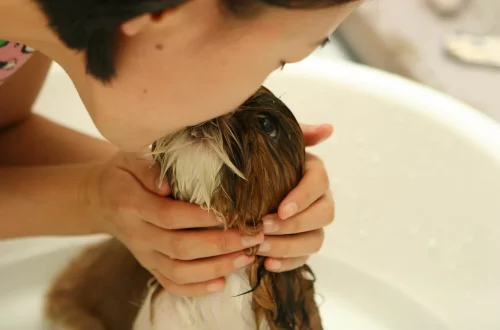
Understanding Meniscus Tear in Dogs: Symptoms and Treatment Options
Understanding a meniscus tear in dogs is crucial for pet owners who want to ensure the health and mobility of their furry companions. The meniscus is a C-shaped cartilage located in the knee joint, acting as a cushion and stabilizer. It plays a vital role in absorbing shock and maintaining proper joint function. When a tear occurs, it can lead to significant pain and discomfort for the dog, impacting their quality of life.
A meniscus tear can happen due to various reasons including injury, overexertion, or degenerative changes. Certain breeds are more predisposed to joint issues, making them more susceptible to conditions like meniscus tears. Recognizing the signs and symptoms early on can be pivotal in managing the condition effectively. Most importantly, prompt veterinary attention is essential for diagnosing the issue and setting a treatment plan that could range from conservative methods to surgical intervention.
Understanding the causes, symptoms, and treatment options for meniscus tears not only helps pet owners make informed decisions but also fosters a proactive approach to their dog’s health. Maintaining a keen awareness of your dog’s behavior and physical condition can lead to early detection and better outcomes.
Common Symptoms of Meniscus Tears in Dogs
Identifying the symptoms of a meniscus tear in dogs is vital for early intervention. Dogs cannot verbally express their discomfort, so pet owners must be attentive to subtle behavioral changes. One of the most common indicators is limping or favoring one leg. If your dog hesitates to put weight on a specific limb, it may indicate pain in the affected knee joint.
Another symptom to watch for is swelling around the knee area. This can be accompanied by heat or tenderness, making it uncomfortable for your dog to engage in regular activities. You may also notice stiffness, particularly after periods of rest. This stiffness can make it challenging for your dog to rise from a lying position or to jump into the car.
In addition to physical signs, behavioral changes can also indicate a meniscus tear. Dogs may become less active or reluctant to play due to the pain they experience. They might also show signs of irritability or distress when their leg is touched or manipulated. If your dog displays any of these symptoms, it is crucial to consult a veterinarian for a thorough examination.
Another noteworthy symptom is the presence of a clicking or popping sound when your dog moves their knee. This can occur due to the torn meniscus catching on the joint surfaces. This auditory indicator, combined with physical symptoms, may help your veterinarian in diagnosing the issue.
In summary, being vigilant about your dog’s behavior and physical condition can help in the early detection of a meniscus tear. If you suspect your dog might be suffering from this condition, immediate veterinary attention is essential to ensure the best possible outcome.
Diagnosis of Meniscus Tears in Dogs
Diagnosing a meniscus tear in dogs typically involves a combination of physical examinations and diagnostic imaging. The initial step usually includes a thorough physical examination by a veterinarian. During this examination, the vet will assess your dog’s range of motion, check for swelling or tenderness, and look for any audible signs of a tear.
Veterinarians may also perform specific maneuvers, like the McMurray test, which involves manipulating the knee joint to elicit clicking sounds indicative of a meniscus tear. This hands-on assessment is crucial for pinpointing the injury but is often followed by imaging to confirm the diagnosis.
Radiographs, or X-rays, are commonly employed to rule out other potential issues, such as bone fractures or arthritis. However, X-rays cannot directly visualize soft tissues like cartilage. Therefore, the vet may recommend advanced imaging techniques, such as Magnetic Resonance Imaging (MRI) or Ultrasound. These methods provide a clearer view of the soft tissues within the knee joint, allowing for a more accurate diagnosis.
Once the diagnosis is confirmed, the veterinarian will discuss the severity of the tear and the potential impact on your dog’s overall health. This is essential for determining the best course of action, which may include conservative treatments such as rest and physical therapy, or more invasive options like surgery.
In conclusion, effective diagnosis of a meniscus tear relies on a combination of physical exams and advanced imaging techniques. If your dog is exhibiting symptoms, it is essential to seek veterinary care promptly to ensure an accurate diagnosis and appropriate treatment plan.
Treatment Options for Meniscus Tears in Dogs
The treatment options for meniscus tears in dogs vary depending on the severity of the tear and the overall health of the dog. Conservative treatment is often the first line of defense, especially for minor tears. This typically involves rest and restricted activity to allow the knee joint to heal. Your veterinarian may recommend a period of several weeks during which your dog should avoid strenuous activities, such as running or jumping.
In addition to rest, anti-inflammatory medications can be prescribed to help manage pain and reduce swelling. These medications are essential for keeping your dog comfortable during the recovery phase. Physical therapy may also be recommended to help strengthen the muscles surrounding the knee, improving stability and function over time.
If the tear is more severe or if conservative treatments do not yield satisfactory results, surgical intervention may be necessary. The most common surgical procedure for meniscus tears is called a meniscectomy, where the damaged portion of the meniscus is removed. This procedure aims to alleviate pain and restore function to the joint.
In some cases, more complex surgical techniques, such as meniscal repair, may be appropriate. This involves suturing the torn edges of the meniscus together to promote healing. However, not all dogs are candidates for repair, and the decision will depend on the type and location of the tear.
Post-operative care is crucial for a successful recovery. Your veterinarian will provide you with specific guidelines on activity restrictions, pain management, and rehabilitation exercises. Regular follow-up appointments will be necessary to monitor your dog’s progress and make any adjustments to the treatment plan as needed.
In summary, treatment options for meniscus tears in dogs range from conservative methods to surgical intervention, depending on the severity of the injury. It is essential to work closely with your veterinarian to determine the best approach for your dog’s specific situation.
Preventing Meniscus Tears in Dogs
Preventing meniscus tears in dogs is an essential aspect of pet ownership. While some factors, such as genetics and age, are beyond our control, there are several proactive measures you can take to help reduce the risk of joint injuries.
Regular exercise is crucial for maintaining healthy joints and muscles. Ensure that your dog engages in age-appropriate activities that promote strength and flexibility. Avoid overly strenuous activities, especially for puppies or older dogs, as these can lead to injuries.
Weight management is another vital factor in joint health. Excess weight places additional stress on your dog’s joints, increasing the risk of injuries like meniscus tears. A balanced diet and regular exercise can help maintain a healthy weight, reducing the strain on the knees.
Routine veterinary check-ups are also essential for early detection of potential issues. Your veterinarian can assess your dog’s joint health and provide recommendations tailored to their specific needs. If your dog is predisposed to joint problems, they may suggest preventive supplements, such as glucosamine and chondroitin, which can support joint health.
Additionally, providing a safe environment can help prevent accidents. Remove hazards in your home and yard that could cause slips or falls. Be mindful of the surfaces your dog walks on, as slippery floors can lead to injuries.
In conclusion, while it may not be possible to eliminate the risk of meniscus tears completely, taking preventive measures can significantly reduce the likelihood of such injuries. Regular exercise, weight management, routine vet visits, and a safe environment are all essential components of maintaining your dog’s joint health.
—
**Disclaimer:** This article is for informational purposes only and does not constitute medical advice. For any health concerns regarding your dog, please consult a qualified veterinarian.




